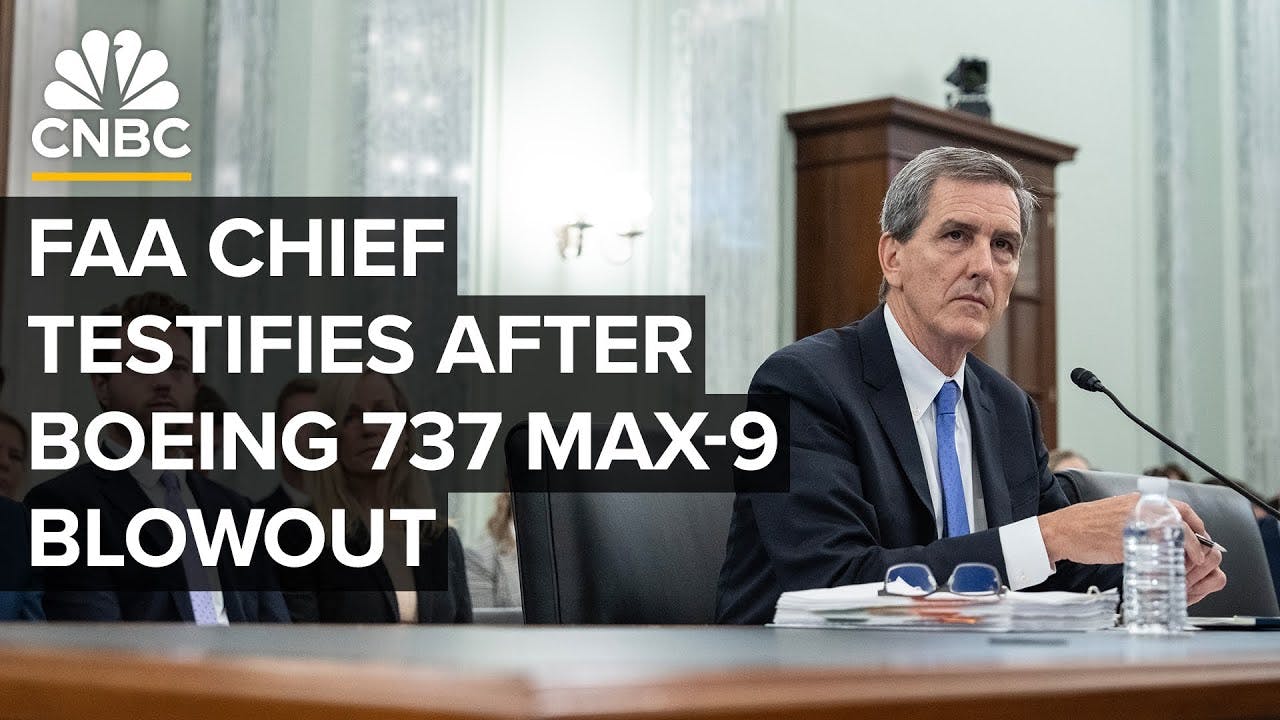FAA chief Michael Whitaker testifies before Congress after Boeing 737 Max-9 blowout — 2/6/2024
()

FAA Reauthorization Bill
- The House passed a strong bipartisan FAA reauthorization bill months ago, but the Senate has failed to act on it, resulting in the loss of $650 million in airport investments and delaying important safety measures.
- The FAA needs a long-term comprehensive reauthorization bill to address numerous issues, including aircraft manufacturing defects, engine fires, near misses, ramp worker deaths, pilot mental health issues, poor customer service, and the integration of drones, Advanced Air Mobility Vehicles, commercial space transportation, and cybersecurity into the national airspace system.
- The House bill contains provisions to address each of these issues and has received support from all corners of the aviation sector.
- The Senate's inaction has real-world consequences that directly affect American leadership in aviation and the safety of the traveling public.
- The Senate is urged to move forward with the FAA reauthorization bill to ensure the FAA and NTSB have the necessary authorities and resources.
- The FAA is urged to start laying the groundwork for efficient agency implementation of the provisions in line with Congressional intent.
Boeing 737 MAX 9 Incident
- The FAA grounded the Boeing 737 Max 9 aircraft after an incident involving Alaska Airlines flight 1282 and is conducting a thorough audit of Boeing's production and quality control practices.
- The FAA is considering further action with SMS requirements for aircraft part suppliers and other entities involved in aircraft manufacturing.
- The Boeing 737 MAX 9 incident raised concerns about aircraft quality control issues, and Boeing's safety culture needs to be examined and improved.
- The FAA is reviewing the delegation of production oversight and quality assurance functions to Boeing and is proposing to expand the oversight approach to include both audit and inspection.
- The FAA is working to implement the Aircraft Certification Safety and Accountability Act, including completing work on SMS systems, conducting a culture survey of Boeing's safety culture, updating the ODA policy, and incorporating ODA best practices into its processes.
Airport Infrastructure and Funding
- Phoenix-Mesa Gateway Airport, the busiest contract air traffic control tower in the region, recently completed its new Terminal South Concourse with the help of $14.4 million from the bipartisan infrastructure law.
- The FAA supports general aviation and rural airport investment and infrastructure.
- The FAA recognizes the importance of funding and authorization for airport modernization projects and is committed to working with stakeholders to ensure these projects can proceed.
Whistleblower Concerns
- The FAA has a hotline and a specific hotline for Boeing employees where they can report concerns or whistleblow. The hotline can be accessed through the FAA's website (faa.gov).
- The FAA has a confidential process for whistleblowers to report concerns.
- A whistleblower revealed a plan to house illegal immigrants in 10 different airports, including Atlantic City International Airport.
- Congressman demands a thorough investigation into the involvement of airports, a complete list of airports involved, and a policy from the FAA regarding such requests.
Staffing and Workforce Development
- The FAA is actively hiring air traffic controllers, mechanics, pilots, and other aviation personnel to address workforce shortages.
- The FAA is working with universities and the private sector to increase the pipeline of air traffic controllers.
- The FAA is working to implement the Collegiate Training Initiative (CTI) program to address the shortage of air traffic controllers.
- The FAA aims to have half of the CTI schools training students by the fall of 2024.
Safety and Oversight
- The FAA's prompt response to the Boeing 737 MAX 9 incident and the audit of Boeing are commendable, but complacency cannot be afforded when it comes to aviation safety.
- Safety is the committee's top priority, and the FAA must have the resources and tools to conduct investigations, audits, and enforcement actions effectively.
- The FAA reauthorization bill addresses safety gaps identified in the recent NAS Safety Review Team report, including hiring air traffic controllers and installing advanced surveillance technology.
- The FAA is taking steps to address several key issues, including increasing the controller workforce, mitigating controller fatigue, and continuously improving safety processes and procedures.
- The FAA is considering options for oversight of Boeing, including third-party quality control.
- The FAA is working on developing regulations for beyond visual line of sight (BVLOS) operations and expects to release a proposed rulemaking (MPRM) this year.
- The FAA is committed to working with Congress to ensure that the provisions of the upcoming FAA reauthorization bill are implemented efficiently and effectively.
- The FAA is considering issuing a final rule on seat dimensions, taking into account comments received from the public.
Modernization and Technology
- The FAA's aging infrastructure, particularly the Instrument Landing Systems (ILS), poses a risk to the flying public.
- Despite funding allocated in the bipartisan infrastructure law, the FAA has not provided a satisfactory response on the timeline and budget for modernizing ILS systems